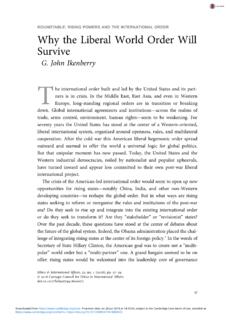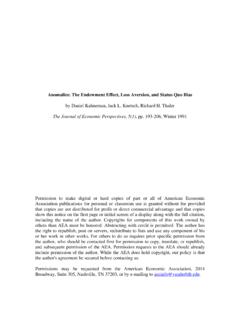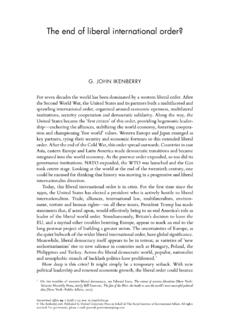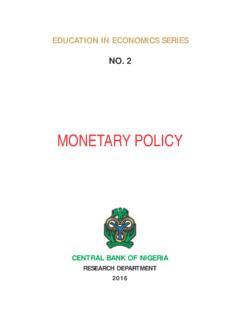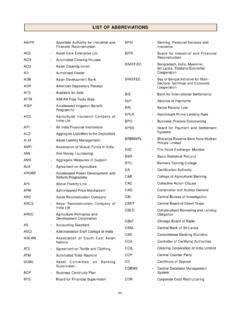Transcription of The I Theory of Money - Princeton University
1 The I Theory of Money . Markus K. Brunnermeier and Yuliy Sannikov . August 8, 2016. Abstract A Theory of Money needs a proper place for financial intermediaries. Intermediaries diversify risks and create inside Money . In downturns, micro-prudent intermediaries shrink their lending activity, fire-sell assets and supply less inside Money , exactly when Money demand rises. The resulting Fisher disinflation hurts intermediaries and other borrowers. Shocks are amplified, volatility spikes and risk premia rise.
2 monetary policy is redistributive. Accommodative monetary policy that boosts assets held by balance sheet-impaired sectors, recapitalizes them and mitigates the adverse liquidity and disinflationary spirals. Since monetary policy cannot provide insurance and control risk-taking separately, adding macroprudential policy that limits leverage attains higher welfare. Keywords: monetary Economics, (Inside) Money , Endogenous Risk Dynamics, Volatility Paradox, Paradox of Prudence, Financial Frictions. JEL Codes: E32, E41, E44, E51, E52, E58, G01, G11, G21.
3 We are grateful to comments by discussants Doug Diamond, Mike Woodford, Marco Bassetto, Itamar Drechsler, Michael Kumhoff, Alexi Savov and seminar participants at various universities and conferences.. Brunnermeier: Department of Economics, Princeton University , Sannikov: De- partment of Economics, Princeton University , 1. 1 Introduction A Theory of Money needs a proper place for financial intermediaries. Financial institutions are able to create Money when they extend loans to businesses and home buyers, they credit the borrowers with deposits and so create inside Money .
4 Money creation by financial intermediaries depends crucially on the health of the banking system and the presence of profitable investment opportunities. This paper proposes a Theory of Money and provides a framework for analyzing the interaction between price stability and financial stability. It therefore provides a unified way of thinking about monetary and macroprudential policy . We model Money supply and demand, and the role of financial intermediaries as follows. Households manage productive projects that use capital and expose them to idiosyncratic risk.
5 They hold Money for self insurance against this risk. This creates Money demand - as in Samuelson (1958) and Bewley (1980) Money has value in equilibrium even though it never pays dividends - in other words Money is a bubble. Money supply consists of outside Money and inside Money created by intermediaries. Intermediaries take stakes in the households' risky projects, absorbing and diversifying some of households' risk. They are active in maturity and liquidity transformation, as they issue liquid, at notice redeemable, (inside) Money and invest in illiquid long-term assets.
6 The mismatch between assets and liabilities exposes intermediaries to risk. When intermediaries suffer losses, they shrink their balance sheets, creating less inside Money and financing fewer household projects. In this case Money supply shrinks and Money demand rises. Together, both effects lead to increase in the value of outside Money , disinflation a la Fisher (1933) occurs. The relationship between the value of Money and the state of the financial system can be understood through two polar cases.
7 In one polar case intermediaries are undercapitalized and cannot perform their functions. Without inside Money , Money supply is scarce and the value of Money is high. Households have a desire to hold Money which, unlike the households'. risky projects, is subject only to aggregate, not idiosyncratic, risk. In the opposite polar case, intermediaries are well capitalized and so well equipped to mitigate financial frictions. They are able to exploit the diversification benefits by investing across many different projects.
8 Intermediaries also create inside Money and hence the Money multiplier is high. At the same time, since households can offload some of their idiosyncratic risks to the intermediary sector, their demand for Money is low. Hence, the value of Money is low in this polar case. An adverse shock to end borrowers not only hurts the intermediaries directly, but also moves the economy closer to the first polar regime with high value of Money . Shocks are 2. amplified by spirals on both sides of intermediaries' balance sheets.
9 On the asset side, in- termediaries are exposed to productivity shocks of their end-borrowers. End-borrowers' fire sales depress the price of physical capital and liquidity spirals further erode intermediaries'. net worth (as shown in Brunnermeier and Sannikov (2014)). On the liabilities side, inter- mediaries are hurt by the Fisher disinflation. As lending and inside Money creation shrink, Money demand rises and the real value of nominal liabilities expands. The Paradox of Prudence arises when intermediaries shrink their balance sheet and households tilt their portfolio away from real investment towards the safe asset, Money .
10 Scaling back risky asset holding is micro-prudent, but makes the economy more risky, it is macro-imprudent. Our Paradox of Prudence is in the risk space what Keynes' Paradox of Thrift is for the consumption-savings decision. The Paradox of thrift describes how each person's attempt to save more paradoxically lowers overall aggregate savings. In our model attempts to reduce in- dividual risks increases endogenous risks as the economy's capacity to diversify idiosyncratic risk moves around endogenously.







